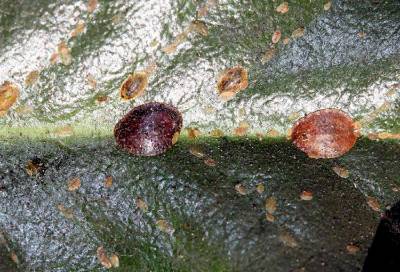Scale on Houseplants

Scale insects come in various shapes, sizes, types, and colors. I call scale insects the sneaky killers because they often go unlooked compared to their flashier friends, such as mealybugs, spider mites, and aphids. Scale insects come in various shapes, but one thing they all have in common is a waxy or shell-like covering. Most scale insects are tan or brown, but some have a white fuzzy covering similar to mealy bugs. They are typically less than ¼” in length, which helps them blend into the plants they live on. The photo to the right shows both adult and nymph or “crawler” scale insects. Scale insects feed on plants by sucking the sap out of the leaves or stems. Most often the infestation is discovered by the stunted growth of the plant or the presence of “honeydew” which is a sticky substance excreted by the insects. Control can be difficult since the waxy covering of the insect protects it from many insecticides. For lightly infested plants, use a Q-tip and rubbing alcohol to rub off all the scale insects you can see. For heavier-infested plants, you will want to move them outside and spray using a chemical with active ingredients, including insecticidal soaps, pyrethrin, rotenone, resmethrin, and acephate. Depending on the product label, you will have to cover the plant thoroughly and spray every week or so for a month to get adequate control if the plant regrows after being pruned back, cut off the areas with the heaviest infestation, and then treat. If the plant is heavily infested, it might be best to throw it away and start over.

Have questions? Contact our office where our Horticulture Extension Agent will assist you with questions.
Phone: (316) 321-9660
Email: callae@ksu.edu